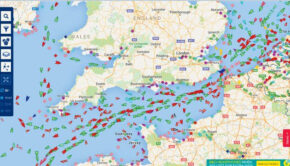Safety of Life at Sea
Published on June 1st, 2020
That there was a collision in the 2017-18 Volvo Ocean Race offshore China was not a shocker. Ever since this crewed offshore event had included Asia in its course, conflict with commercial traffic was the norm. Same goes for the Clipper Round the World Yacht Race. On an AIS map, it’s hard to see the water between the dots.
While the commercial attractiveness of the region defined the course, competitors faced danger to arrive. At the low end, it’s snagging fishing nets. At the high end, it’s Volvo team Vestas 11th Hour Racing colliding with a fishing boat just 30 nm from the Hong Kong finish, sinking the boat and killing one fisherman.
Beyond the internal secrecy and legal settlements, the outside conversation turned toward the COREGS, the international “rules of the road” to prevent collisions at sea. With the tracker reporting Vestas was blast reaching at 20 knots and visibility impaired by darkness and spray, they arguably were in conflict with the most basic tenet of the COLREGS – only proceed at a safe speed.
But this is a race, the finish was near, and within the fleet there was little room to throttle back. With the course taking teams into harm’s way, the Organizing Authority commissioned an independent report to examine racing at night in areas of high vessel traffic density. When released, it was a detailed assessment that sailing fast in congestion is dangerous.
While competitive sailing focuses on the Racing Rules of Sailing, all boaters need to be familiar with the COLREGS. To assist in that mission, Vincent Pica takes on the challenge in WindCheck Magazine …
It has been over 14 years since we approached the “COLREGs” in a systematic way, from stem to stern. This column (re)starts that.
Every boater has (hopefully) heard of the rule of “red, right, return,” meaning to keep the red buoys on your right when returning from sea. What many don’t realize is that this old chestnut is one of many that represent the embedded knowledge of centuries of seafaring know formally as the “International Regulations for the Prevention of Collision at Sea” and the largely parallel United States Inland Rules.
Sometimes referred to by the old salts as the “COLREGS” or simply “The Rules,” it has been estimated that less than 10% of today’s boaters are familiar with them. And the IMO (International Maritime Organization) estimates that 80% of all collisions at sea are due to “pilot error…” So, this column begins anew a series of articles on The Rules that have one simple goal: Safety of Life at Sea. Full report.









 We’ll keep your information safe.
We’ll keep your information safe.